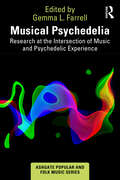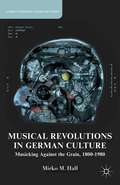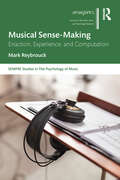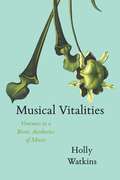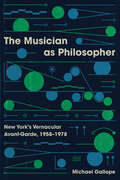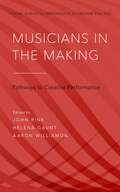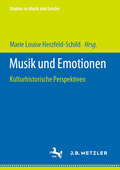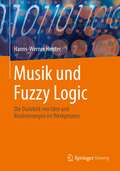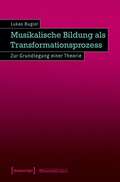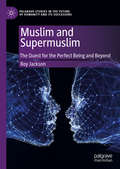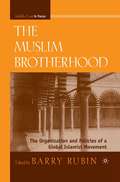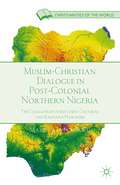- Table View
- List View
Musical Performance: A Philosophical Study
by Stan GodlovitchMost music we hear comes to us via a recording medium on which sound has been stored. Such remoteness of music heard from music made has become so commonplace it is rarely considered. Musical Performance: A Philosophical Study considers the implications of this separation for live musical performance and music-making. Rather than examining the composition or perception of music as most philosophical accounts of music do, Stan Godlovitch takes up the problem of how the tradition of active music playing and performing has been challenged by technology and what problems this poses for philosophical aesthetics. Where does does the value of musical performance lie? Is human performance of music a mere transfer medium? Is the performance of music more expressive than recorded music? Musical Performance poses questions such as these to develop a fascinating account of music today. musicians - but via some recording medium on which sound has been stored.
Musical Performance: A Philosophical Study
by Stan GodlovitchMost music we hear comes to us via a recording medium on which sound has been stored. Such remoteness of music heard from music made has become so commonplace it is rarely considered. Musical Performance: A Philosophical Study considers the implications of this separation for live musical performance and music-making. Rather than examining the composition or perception of music as most philosophical accounts of music do, Stan Godlovitch takes up the problem of how the tradition of active music playing and performing has been challenged by technology and what problems this poses for philosophical aesthetics. Where does does the value of musical performance lie? Is human performance of music a mere transfer medium? Is the performance of music more expressive than recorded music? Musical Performance poses questions such as these to develop a fascinating account of music today. musicians - but via some recording medium on which sound has been stored.
Musical Psychedelia: Research at the Intersection of Music and Psychedelic Experience (Ashgate Popular and Folk Music Series)
by Gemma L. FarrellPsychedelic music is a fascinating yet under-researched field of study. This thought-provoking collection offers a broad introduction to the fi eld of psychedelic music studies, bringing together scholarly work on psychedelic music in genres like rock, folk, electronic dance music and pop. Through an expanded purview on psychedelic music, an emerging trend in research, the collection affords students and academics alike an introduction to a rich, multi-faceted field. The contributing authors explore a range of different facets of musical psychedelia: its transgressive and transcendent aspects, its foregrounding of timbre and texture, the way it changes our perception of time, its influence on “non-psychedelic” music, key composition and production techniques that composers and musicians use in its creation, how it is mediated by different places and spaces, and the interplay between psychedelic visual and sonic aesthetics. This interdisciplinary work reveals both commonalities in musical psychedelic experiences and the contestation inherent in a fi eld of study that juxtaposes music of different genres and eras with a variety of theoretical approaches and methodologies. In broadening the scope of psychedelic music research, the collection not only makes for varied and absorbing reading on the subject level but also stimulates reflexive thought about interdisciplinary research.
Musical Psychedelia: Research at the Intersection of Music and Psychedelic Experience (Ashgate Popular and Folk Music Series)
Psychedelic music is a fascinating yet under-researched field of study. This thought-provoking collection offers a broad introduction to the fi eld of psychedelic music studies, bringing together scholarly work on psychedelic music in genres like rock, folk, electronic dance music and pop. Through an expanded purview on psychedelic music, an emerging trend in research, the collection affords students and academics alike an introduction to a rich, multi-faceted field. The contributing authors explore a range of different facets of musical psychedelia: its transgressive and transcendent aspects, its foregrounding of timbre and texture, the way it changes our perception of time, its influence on “non-psychedelic” music, key composition and production techniques that composers and musicians use in its creation, how it is mediated by different places and spaces, and the interplay between psychedelic visual and sonic aesthetics. This interdisciplinary work reveals both commonalities in musical psychedelic experiences and the contestation inherent in a fi eld of study that juxtaposes music of different genres and eras with a variety of theoretical approaches and methodologies. In broadening the scope of psychedelic music research, the collection not only makes for varied and absorbing reading on the subject level but also stimulates reflexive thought about interdisciplinary research.
Musical Revolutions in German Culture: Musicking against the Grain, 1800-1980 (Studies in European Culture and History)
by M. HallDrawing upon the philosophical insights of Friedrich Schlegel, Walter Benjamin, Theodor W. Adorno, and Blixa Bargeld, this book explores the persistence of a critical-deconstructive approach to musical production, consumption, and reception in the German cultural sphere of the last two centuries.
Musical Sense-Making: Enaction, Experience, and Computation (SEMPRE Studies in The Psychology of Music)
by Mark ReybrouckMusical Sense-Making: Enaction, Experience, and Computation broadens the scope of musical sense-making from a disembodied cognitivist approach to an experiential approach. Revolving around the definition of music as a temporal and sounding art, it argues for an interactional and experiential approach that brings together the richness of sensory experience and principles of cognitive economy. Starting from the major distinction between in-time and outside-of-time processing of the sounds, this volume provides a conceptual and operational framework for dealing with sounds in a real-time listening situation, relying heavily on the theoretical groundings of ecology, cybernetics, and systems theory, and stressing the role of epistemic interactions with the sounds. These interactions are considered from different perspectives, bringing together insights from previous theoretical groundings and more recent empirical research. The author’s findings are framed within the context of the broader field of enactive and embodied cognition, recent action and perception studies, and the emerging field of neurophenomenology and dynamical systems theory. This volume will particularly appeal to scholars and researchers interested in the intersection between music, philosophy, and/or psychology.
Musical Sense-Making: Enaction, Experience, and Computation (SEMPRE Studies in The Psychology of Music)
by Mark ReybrouckMusical Sense-Making: Enaction, Experience, and Computation broadens the scope of musical sense-making from a disembodied cognitivist approach to an experiential approach. Revolving around the definition of music as a temporal and sounding art, it argues for an interactional and experiential approach that brings together the richness of sensory experience and principles of cognitive economy. Starting from the major distinction between in-time and outside-of-time processing of the sounds, this volume provides a conceptual and operational framework for dealing with sounds in a real-time listening situation, relying heavily on the theoretical groundings of ecology, cybernetics, and systems theory, and stressing the role of epistemic interactions with the sounds. These interactions are considered from different perspectives, bringing together insights from previous theoretical groundings and more recent empirical research. The author’s findings are framed within the context of the broader field of enactive and embodied cognition, recent action and perception studies, and the emerging field of neurophenomenology and dynamical systems theory. This volume will particularly appeal to scholars and researchers interested in the intersection between music, philosophy, and/or psychology.
Musical Vitalities: Ventures in a Biotic Aesthetics of Music (New Material Histories of Music)
by Holly WatkinsDoes it make sense to refer to bird song—a complex vocalization, full of repetitive and transformative patterns that are carefully calculated to woo a mate—as art? What about a pack of wolves howling in unison or the cacophony made by an entire rain forest? Redefining music as “the art of possibly animate things,” Musical Vitalities charts a new path for music studies that blends musicological methods with perspectives drawn from the life sciences. In opposition to humanist approaches that insist on a separation between culture and nature—approaches that appear increasingly untenable in an era defined by human-generated climate change—Musical Vitalities treats music as one example of the cultural practices and biotic arts of the animal kingdom rather than as a phenomenon categorically distinct from nonhuman forms of sonic expression. The book challenges the human exceptionalism that has allowed musicologists to overlook music’s structural resemblances to the songs of nonhuman species, the intricacies of music’s physiological impact on listeners, and the many analogues between music’s formal processes and those of the dynamic natural world. Through close readings of Austro-German music and aesthetic writings that suggest wide-ranging analogies between music and nature, Musical Vitalities seeks to both rekindle the critical potential of nineteenth-century music and rejoin the humans at the center of the humanities with the nonhumans whose evolutionary endowments and planetary fates they share.
Musical Vitalities: Ventures in a Biotic Aesthetics of Music (New Material Histories of Music)
by Holly WatkinsDoes it make sense to refer to bird song—a complex vocalization, full of repetitive and transformative patterns that are carefully calculated to woo a mate—as art? What about a pack of wolves howling in unison or the cacophony made by an entire rain forest? Redefining music as “the art of possibly animate things,” Musical Vitalities charts a new path for music studies that blends musicological methods with perspectives drawn from the life sciences. In opposition to humanist approaches that insist on a separation between culture and nature—approaches that appear increasingly untenable in an era defined by human-generated climate change—Musical Vitalities treats music as one example of the cultural practices and biotic arts of the animal kingdom rather than as a phenomenon categorically distinct from nonhuman forms of sonic expression. The book challenges the human exceptionalism that has allowed musicologists to overlook music’s structural resemblances to the songs of nonhuman species, the intricacies of music’s physiological impact on listeners, and the many analogues between music’s formal processes and those of the dynamic natural world. Through close readings of Austro-German music and aesthetic writings that suggest wide-ranging analogies between music and nature, Musical Vitalities seeks to both rekindle the critical potential of nineteenth-century music and rejoin the humans at the center of the humanities with the nonhumans whose evolutionary endowments and planetary fates they share.
Musical Vitalities: Ventures in a Biotic Aesthetics of Music (New Material Histories of Music)
by Holly WatkinsDoes it make sense to refer to bird song—a complex vocalization, full of repetitive and transformative patterns that are carefully calculated to woo a mate—as art? What about a pack of wolves howling in unison or the cacophony made by an entire rain forest? Redefining music as “the art of possibly animate things,” Musical Vitalities charts a new path for music studies that blends musicological methods with perspectives drawn from the life sciences. In opposition to humanist approaches that insist on a separation between culture and nature—approaches that appear increasingly untenable in an era defined by human-generated climate change—Musical Vitalities treats music as one example of the cultural practices and biotic arts of the animal kingdom rather than as a phenomenon categorically distinct from nonhuman forms of sonic expression. The book challenges the human exceptionalism that has allowed musicologists to overlook music’s structural resemblances to the songs of nonhuman species, the intricacies of music’s physiological impact on listeners, and the many analogues between music’s formal processes and those of the dynamic natural world. Through close readings of Austro-German music and aesthetic writings that suggest wide-ranging analogies between music and nature, Musical Vitalities seeks to both rekindle the critical potential of nineteenth-century music and rejoin the humans at the center of the humanities with the nonhumans whose evolutionary endowments and planetary fates they share.
Musical Vitalities: Ventures in a Biotic Aesthetics of Music (New Material Histories of Music)
by Holly WatkinsDoes it make sense to refer to bird song—a complex vocalization, full of repetitive and transformative patterns that are carefully calculated to woo a mate—as art? What about a pack of wolves howling in unison or the cacophony made by an entire rain forest? Redefining music as “the art of possibly animate things,” Musical Vitalities charts a new path for music studies that blends musicological methods with perspectives drawn from the life sciences. In opposition to humanist approaches that insist on a separation between culture and nature—approaches that appear increasingly untenable in an era defined by human-generated climate change—Musical Vitalities treats music as one example of the cultural practices and biotic arts of the animal kingdom rather than as a phenomenon categorically distinct from nonhuman forms of sonic expression. The book challenges the human exceptionalism that has allowed musicologists to overlook music’s structural resemblances to the songs of nonhuman species, the intricacies of music’s physiological impact on listeners, and the many analogues between music’s formal processes and those of the dynamic natural world. Through close readings of Austro-German music and aesthetic writings that suggest wide-ranging analogies between music and nature, Musical Vitalities seeks to both rekindle the critical potential of nineteenth-century music and rejoin the humans at the center of the humanities with the nonhumans whose evolutionary endowments and planetary fates they share.
The Musician as Philosopher: New York’s Vernacular Avant-Garde, 1958–1978
by Michael GallopeAn insightful look at how avant-garde musicians of the postwar period in New York explored the philosophical dimensions of music’s ineffability. The Musician as Philosopher explores the philosophical thought of avant-garde musicians in postwar New York: David Tudor, Ornette Coleman, the Velvet Underground, Alice Coltrane, Patti Smith, and Richard Hell. It contends that these musicians—all of whom are understudied and none of whom are traditionally taken to be composers—not only challenged the rules by which music is written and practiced but also confounded and reconfigured gendered and racialized expectations for what critics took to be legitimate forms of musical sound. From a broad historical perspective, their arresting music electrified a widely recognized social tendency of the 1960s: a simultaneous affirmation and crisis of the modern self.
The Musician as Philosopher: New York’s Vernacular Avant-Garde, 1958–1978
by Michael GallopeAn insightful look at how avant-garde musicians of the postwar period in New York explored the philosophical dimensions of music’s ineffability. The Musician as Philosopher explores the philosophical thought of avant-garde musicians in postwar New York: David Tudor, Ornette Coleman, the Velvet Underground, Alice Coltrane, Patti Smith, and Richard Hell. It contends that these musicians—all of whom are understudied and none of whom are traditionally taken to be composers—not only challenged the rules by which music is written and practiced but also confounded and reconfigured gendered and racialized expectations for what critics took to be legitimate forms of musical sound. From a broad historical perspective, their arresting music electrified a widely recognized social tendency of the 1960s: a simultaneous affirmation and crisis of the modern self.
Musicians in the Making: Pathways to Creative Performance (Studies in Musical Performance as Creative Practice)
by John Rink, Helena Gaunt and Aaron WilliamonMusicians are continually 'in the making', tapping into their own creative resources while deriving inspiration from teachers, friends, family members and listeners. Amateur and professional performers alike tend not to follow fixed routes in developing a creative voice: instead, their artistic journeys are personal, often without foreseeable goals. The imperative to assess and reassess one's musical knowledge, understanding and aspirations is nevertheless a central feature of life as a performer. Musicians in the Making explores the creative development of musicians in both formal and informal learning contexts. It promotes a novel view of creativity, emphasizing its location within creative processes rather than understanding it as an innate quality. It argues that such processes may be learned and refined, and furthermore that collaboration and interaction within group contexts carry significant potential to inform and catalyze creative experiences and outcomes. The book also traces and models the ways in which creative processes evolve over time. Performers, music teachers and researchers will find the rich body of material assembled here engaging and enlightening. The book's three parts focus in turn on 'Creative learning in context', 'Creative processes' and 'Creative dialogue and reflection'. In addition to sixteen extended chapters written by leading experts in the field, the volume includes ten 'Insights' by internationally prominent performers, performance teachers and others. Practical aids include abstracts and lists of keywords at the start of each chapter, which provide useful overviews and guidance on content. Topics addressed by individual authors include intrapersonal and interpersonal dynamics, performance experience, practice and rehearsal, 'self-regulated performing', improvisation, self-reflection, expression, interactions between performers and audiences, assessment, and the role of academic study in performers' development.
Musicians in the Making: Pathways to Creative Performance (Studies in Musical Performance as Creative Practice)
Musicians are continually 'in the making', tapping into their own creative resources while deriving inspiration from teachers, friends, family members and listeners. Amateur and professional performers alike tend not to follow fixed routes in developing a creative voice: instead, their artistic journeys are personal, often without foreseeable goals. The imperative to assess and reassess one's musical knowledge, understanding and aspirations is nevertheless a central feature of life as a performer. Musicians in the Making explores the creative development of musicians in both formal and informal learning contexts. It promotes a novel view of creativity, emphasizing its location within creative processes rather than understanding it as an innate quality. It argues that such processes may be learned and refined, and furthermore that collaboration and interaction within group contexts carry significant potential to inform and catalyze creative experiences and outcomes. The book also traces and models the ways in which creative processes evolve over time. Performers, music teachers and researchers will find the rich body of material assembled here engaging and enlightening. The book's three parts focus in turn on 'Creative learning in context', 'Creative processes' and 'Creative dialogue and reflection'. In addition to sixteen extended chapters written by leading experts in the field, the volume includes ten 'Insights' by internationally prominent performers, performance teachers and others. Practical aids include abstracts and lists of keywords at the start of each chapter, which provide useful overviews and guidance on content. Topics addressed by individual authors include intrapersonal and interpersonal dynamics, performance experience, practice and rehearsal, 'self-regulated performing', improvisation, self-reflection, expression, interactions between performers and audiences, assessment, and the role of academic study in performers' development.
Musik und Emotionen: Kulturhistorische Perspektiven (Studien zu Musik und Gender)
Musik und Emotionen haben Konjunktur, und zwar nicht erst seit Emotionen in Wissenschaft, Ratgeberliteratur und Journalismus zu einem der Hauptthemen geworden sind. Die Verbindung zwischen diesen beiden ephemeren Phänomenen geht bis in die Antike zurück, und sie ist weit komplexer als es die weitläufig bekannte Formulierung, Musik sei die Sprache der Gefühle, erahnen lässt. Im vorliegenden Band werden zum ersten Mal Herangehensweisen aus der Historischen Musikwissenschaft, der Tanzwissenschaft und den Sound Studies mit Ansätzen aus der Emotionsgeschichte verbunden, um den vielschichtigen Zusammenhang zwischen Musik und Emotionen aus einer kulturhistorischen Perspektive zu beschreiben.
Musik und Fuzzy Logic: Die Dialektik von Idee und Realisierungen im Werkprozess
by Hanns-Werner HeisterDas Buch entfaltet die vielfältigen Wechselbeziehungen zwischen Fuzzy Logic und Musik in einem ersten umfassenden Überblick. Es behandelt systematisch sowohl die in diesem Zusammenhang relevanten Aspekte der Fuzzy Logic als auch die der Musik. Im Werkprozess mit drei Hauptphasen und dreizehn Existenzformen des Kunstwerks, in den Musikarten Klassik, Jazz, Pop, Folklore, zeigen sich die vier Hauptprinzipien (mit fünf Phänotypen) der Fuzzy Logic in Bezug auf die Musik: Ähnlichkeit, Schärfung I als Filterung und Schärfung II als Kristallisation, Verwischung, Variation. Ein neues Konzept ist die Dialektik zwischen Schärfung und – bewusster – "Unschärfe" durch die Verwischung. Abschließend werden Aspekte der mehrdimensionalen Dialektik in historischer Dimension entwickelt, samt einem ‚Musical Turn‘ in den Wissenschaften und Überlegungen zu einer 'Philosophie der FL'. Das produktionsorientierte Denken der Fuzzy Logic und die Musik-Analyse befruchten sich wechselseitig.
Musikalische Bildung als Transformationsprozess: Zur Grundlegung einer Theorie (Theorie Bilden #42)
by Lukas BugielIrritierende Erfahrungen mit Musik können dazu führen, dass sich wandelt, wie man Welt und sich selbst erfährt. Lukas Bugiel entfaltet diesen Gedanken zwischen Bildungstheorie, Musikpädagogik und Philosophie durch die Entwicklung einer Theorie transformatorischer musikalischer Bildungsprozesse. Mit einem Begriff von Ereignis und Wissen gewinnt er ein philosophisches Verständnis des Auslösers und des Gegenstands dieser Prozesse und skizziert, wie sie sich anhand von Biographien empirisch rekonstruieren lassen könnten.
Musings on the Meno (Nijhoff Classical Philosophy Library #1)
by J.E. ThomasThe objectives of this book are to provide a new translation of Plato's M eno together with a series of studies on its philcisophical argument in the light of recent secondary literature. My translation is based mainly on the Oxford Classical Text, 1. Burnet's Platonis Opera (Oxford Clarendon Press 1900) Vol. III. In conjunction with this I have made extensive use of R.S. Bluck's Plato's Meno (Cam bridge University Press, 1964). At critical places in the dialogue I have also consulted A. Croiset's Gorgias, Menon (Bude text). My debt ~o two other sources will be clearly in evidence. They are E.S. Thompson's Plato's Meno (London, MacMillan 1901), and St. George Stock's The Meno of Plato (Oxford Clarendon Press, 1894). One of the greatest difficulties facing a translator is to achieve a balance between accuracy and elegance. Literal translations are more likely to be accurate, but, alas, they also tend to be duller. Free translations run into the opposite danger of paying for elegance and liveliness with the coin of inaccuracy. Another hurdle, for a translator of a Platonic dialogue, is posed by the challenge to maintain the conversational pattern and fast moving character of the discussion. This is easier where the exchang~s are short, but much more difficult where Socrates gets somewhat long-winded.
Muslim and Supermuslim: The Quest for the Perfect Being and Beyond (Palgrave Studies in the Future of Humanity and its Successors)
by Roy JacksonThis book looks to the rich and varied Islamic tradition for insights into what it means to be human and, by implication, what this can tell us about the future human. The transhumanist movement, in its more radical expression, sees Homo sapiens as the cousin, perhaps the poorer cousin, of a new Humanity 2.0: ‘Man’ is replaced by ‘Superman’. The contribution that Islam can make to this movement concerns the central question of what this ‘Superman’ – or ‘Supermuslim’ – would actually entail. To look at what Islam can contribute we need not restrict ourselves to the Qur’an and the legal tradition, but also reach out to its philosophical and literary corpus. Roy Jackson focuses on such contributions from Muslim philosophy, science, and literature to see how Islam can confront and respond to the challenges raised by the growing movement of transhumanism.
The Muslim Brotherhood: The Organization and Policies of a Global Islamist Movement (Middle East in Focus)
by B. RubinThe Muslim Brotherhood is the oldest and most important international Islamist group. Aside from strong organizations in Egypt, Jordan, Syria—where it provides the main opposition—and its Palestinian offshoot Hamas which rules the Gaza Strip, the Brotherhood has become active in Europe and North America.
Muslim-Christian Dialogue in Post-Colonial Northern Nigeria: The Challenges of Inclusive Cultural and Religious Pluralism (Christianities of the World)
by M. IwuchukwuIwuchukwu examines the perennial conflicts in different parts of northern Nigeria and why they are popularly called Muslim-Christian clashes. Specifically, he examines the immediate and remote factors that are responsible for the conflicts.
Muslim Fathers and Mistrusted Masculinity in Danish Schools (Palgrave Macmillan Studies in Family and Intimate Life)
by Anne Hovgaard JørgensenThis book seeks to provide a deeper understanding of Muslim migrant fathers’ experiences of home-school cooperation in Danish schools by identifying and contradicting a phenomenon of “mistrusted masculinity.” This term refers to a negative stereotype of Muslim migrant men that figures in political and media rhetoric where they are portrayed as controlling and patriarchal. Throughout the ethnography, migrant fathers confront this stereotype and express how they must navigate around this negative image in their struggle to be acknowledged as good fathers by their children’s schools. Jørgensen uses Geertzian “thick description” of micro-interaction between fathers and Danish teachers to explore the complex interplay of often-untested assumptions, misunderstandings, and untoward effects.
Muslim Neoplatonists: An Introduction to the Thought of the Brethren of Purity
by Ian Richard NettonThe tenth or eleventh century group of the Brethren of Purity (Ikhwan al Safa) are as well known in the Arab world as Darwin, Marx and Freud in the west. Designed as an introduction to their ideas, this book concentrates on the Brethren's writings, analyzing the impact on them of thinkers such as Pythagoras, Plato, Aristotle and the Neoplatonists. Ian Netton traces the influences of Judaism and Christianity, and controversially this book argues that the Brethren of Purity did not belong to the Ismaili branch of Islam as is generally believed.
Muslim Neoplatonists: An Introduction to the Thought of the Brethren of Purity
by Ian Richard NettonThe tenth or eleventh century group of the Brethren of Purity (Ikhwan al Safa) are as well known in the Arab world as Darwin, Marx and Freud in the west. Designed as an introduction to their ideas, this book concentrates on the Brethren's writings, analyzing the impact on them of thinkers such as Pythagoras, Plato, Aristotle and the Neoplatonists. Ian Netton traces the influences of Judaism and Christianity, and controversially this book argues that the Brethren of Purity did not belong to the Ismaili branch of Islam as is generally believed.

